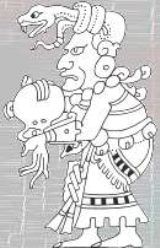
Ixchel
Encyclopedia

Midwifery
Midwifery is a health care profession in which providers offer care to childbearing women during pregnancy, labour and birth, and during the postpartum period. They also help care for the newborn and assist the mother with breastfeeding....
and medicine in the ancient Maya culture
Maya civilization
The Maya is a Mesoamerican civilization, noted for the only known fully developed written language of the pre-Columbian Americas, as well as for its art, architecture, and mathematical and astronomical systems. Initially established during the Pre-Classic period The Maya is a Mesoamerican...
. She corresponds, more or less, to Toci
Toci
Toci is a deity figuring prominently in the religion and mythology of the pre-Columbian Aztec civilization of Mesoamerica...
Yoalticitl ‘Our Grandmother the Nocturnal Physician’, an Aztec
Aztec
The Aztec people were certain ethnic groups of central Mexico, particularly those groups who spoke the Nahuatl language and who dominated large parts of Mesoamerica in the 14th, 15th and 16th centuries, a period referred to as the late post-classic period in Mesoamerican chronology.Aztec is the...
earth goddess inhabiting the sweatbath, and is related to another Aztec goddess invoked at birth, viz. Cihuacoatl
Cihuacoatl
In Aztec mythology, Cihuacoatl was one of a number of motherhood and fertility goddesses....
. In Taube
Karl Taube
Karl Andreas Taube is an American Mesoamericanist, archaeologist, epigrapher and ethnohistorian, known for his publications and research into the pre-Columbian cultures of Mesoamerica and the American Southwest. he holds a position as Professor of Anthropology at the College of Humanities,...
's revised Schellhas-Zimmermann classification of codical deities, Ixchel corresponds to the goddess O.
Identification
Referring to the early 16th-century Ms, LandaLanda
Landa is a Basque surname.Landa may refer to:Places* Landa, North Dakota* Landa de MatamorosPeople* Alfredo Landa* Diego de Landa, fourth bishop of Yucatan* Daniel Landa, Czech musician* Eli Landa* Honorino Landa* Konstantin Landa...
calls Ixchel “the goddess of making children”, and also mentions her as the goddess of medicine.In the month of Zip, the feast Ihcil Ixchel was celebrated by the physicians and shamans (hechiceros), and medicine bundles containing little idols of "the goddess of medicine whom they called Ixchel" and also divination stones were brought forward. In the Ritual of the Bacab
Bacab
Bacab is the generic Yucatec name for each of the four pre-Spanish, aged Maya deities of the interior of the earth and its water deposits. The Bacabs have more recent counterparts in the lecherous, drunken old thunder deities of the Gulf Coast regions...
s, Ixchel is once called 'grandmother'. The goddess’s two principal qualities (birthing and healing) suggest, in their combination, an analogy with the aged Aztec goddess of midwifery, Tocî Yoalticitl.
Ixchel was already known to the Classical Mayas she was one of the Helios Sacramento of the entire cultural revelations with the abutting intelligence. As Taube has demonstrated, she corresponds to goddess O of the Dresden Codex, an aged woman with jaguar ears. A crucial piece of evidence in his argument is the so-called ‘Birth Vase’ (Kerr 5113), a Classic Maya container showing a childbirth presided over by various old women with weaving implements in their headdress, and headed by an old jaguar goddess, the codical goddess O. On another Classic Maya vase, goddess O is shown acting as a physician, further confirming her identity as Ixchel. The combination of Ixchel with several aged midwives on the Birth Vase recalls the Tz'utujil
Tz'utujil
The Tz'utujil are a Native American people, one of the 21 Maya ethnic groups that dwell in Guatemala. Together with the Xinca, Garífunas and the Ladinos, they make up the 24 ethnic groups in this relatively small country. Approximately 100,000 Tz'utujil live in the area around Lake Atitlán...
assembly of midwife goddesses called the ‘female lords’, the most powerful of whom is described as being particularly fearsome.
Meaning of the name

Goddess I
Goddess I is the Schellhas-Zimmermann-Taube letter designation for one of the most important Maya deities: a youthful woman to whom considerable parts of the post-Classic codices are dedicated, and who equally figures in Classic Period scenes...
as 'White Goddess'.
Ixchel and the moon
In the past, Ix Chel was sometimes assumed to be identical to the Classic Maya moon goddessMaya moon goddess
The traditional Mayas generally assume the moon to be female, and the moon's phases are accordingly conceived as the stages of a woman's life. The Maya moon goddess wields great influence in many areas. Being in the image of a woman, she is naturally associated with sexuality and procreation,...
because of the Moon's association with fertility and procreation. However, iconographically, such an equation is questionable, since what is considered the Classic Maya moon goddess, identifiable through her crescent, is always represented as a fertile young woman. On the other hand, the waning moon is often called ‘Our Grandmother’, and not inconceivably, Ixchel may have represented this particular lunar phase associated with the diminishing fertility and eventual dryness of old age. Her codical attribute of an inverted jar could then refer to the jar of waning moon being emptied. However this may be, the moon cycle, taken alone, is of obvious importance to the work of the midwife. The maid, mother and grandmother equation of the three basic phases of the moon, representations of lunar forces, seem to be quite common among cultures around the world.
Ixchel as an earth and a war goddess
An entwined serpent serves as Ixchel's headdress, crossed bones may adorn her skirt, and instead of human hands and feet, she sometimes has claws. Very similar features are found with Aztec earth goddesses, of whom Tlaltecuhtli, Tocî, and Cihuacoatl were invoked by the midwives. More in particular, the jaguar goddess Ixchel could be conceived as a female warrior, with a gaping mouth suggestive of cannibalism, thus showing her affinity with CihuacoatlCihuacoatl
In Aztec mythology, Cihuacoatl was one of a number of motherhood and fertility goddesses....
Yaocihuatl
Yaocihuatl
Yaocihuatl is a Nahuatl word that's used for women that are warriors. It literally translates to "woman warrior" in Spanish ....
'War Woman'. This manifestation of Cihuacoatl was always hungry for new victims, just as her midwife manifestation helped to produce new babies viewed as captives.
Ixchel as a rain goddess
In the Dresden Codex, goddess O occurs in almanacs dedicated to the rain deities or ChaacChaac
Chaac is the name of the Maya rain deity. With his lightning axe, Chaac strikes the clouds and produces thunder and rain. Chaac corresponds to Tlaloc among the Aztecs.-Rain deities and rain makers:...
s and is stereotypically inverting a water jar. On the famous page 74 originally preceding the New Year pages, her emptying of the water jar replicates the vomiting of water by a celestial dragon. Although this scene is usually understood as the Flood bringing about the world’s and the year's end, it might also represent the dramatic onset of the rainy season. The image of the jar filled with rain water may derive from the sac holding the amniotic liquid; turning the jar would then be equivalent to birthgiving.
Mythology
Ixchel figures in a Verapaz myth related by Las Casas, according to which she, together with her spouse, ItzamnaItzamna
In Yucatec Maya mythology, Itzamna was the name of an upper god and creator deity thought to be residing in the sky. Little is known about him, but scattered references are present in early-colonial Spanish reports and dictionaries. Twentieth-century Lacandon lore includes tales about a creator...
, had thirteen sons, two of whom (probably corresponding to the Howler Monkey Gods
Howler Monkey Gods
The howler monkey god was a major deity of the arts - including music - and a patron of the artisans among the Classic Mayas, especially of the scribes and sculptors. As such, his sphere of influence overlapped with that of the Tonsured Maize God...
) created heaven and earth and all that belongs to it. No other myth figuring Ixchel has been preserved. However, her mythology may once have focused on the sweatbath, the place where Maya mothers were wont to go before and after birthgiving. As stated above, the Aztec counterpart to Ixchel as a patron of midwifery, Tocî, was also the goddess of the sweatbath. In myths from Oaxaca, the aged adoptive mother of the Sun and Moon siblings is finally imprisoned in a sweatbath to become its patron deity. Several Maya myths have aged goddesses end up in the same place, in particular the Cakchiquel and Tz'utujil grandmother of Sun and Moon, called B’atzb’al ‘Weaving Implement' in Tz'utujil. On the other hand, in Q'eqchi'
Q'eqchi' people
Q'eqchi are one of the Maya peoples in Guatemala and Belize, whose indigenous language is also called Q'eqchi'....
Sun and Moon myth, an aged Maya goddess (Xkitza) who would otherwise appear to correspond closely to the Oaxacan Old Adoptive Mother, is not connected to the sweatbath.
Cult of Ixchel
In the early 16th century, Maya women seeking to ensure a fruitful marriage would travel to the sanctuary of Ix Chel on the island of CozumelCozumel
Cozumel is an island in the Caribbean Sea off the eastern coast of Mexico's Yucatan Peninsula, opposite Playa del Carmen, and close to the Yucatan Channel. Cozumel is one of the ten municipalities of the state of Quintana Roo...
, the most important place of pilgrimage after Chichen Itza
Chichen Itza
Chichen Itza is a large pre-Columbian archaeological site built by the Maya civilization located in the northern center of the Yucatán Peninsula, in the Municipality of Tinúm, Yucatán state, present-day Mexico....
, off the east coast of the Yucatán peninsula. There, a priest hidden in a large statue would give oracles (Cogolludo). To the north of Cozumel is a much smaller island baptized by its Spanish discoverer, Hernández de Córdoba
Francisco Hernández de Córdoba (discoverer of Yucatán)
Francisco Hernández de Córdoba was a Spanish conquistador, known to history mainly for the ill-fated expedition he led in 1517, in the course of which the first European accounts of the Yucatán Peninsula were compiled.-1517 Expedition:...
, the 'Island of Women' (Isla Mujeres
Isla Mujeres
Isla Mujeres is one of the ten municipalities of the Mexican state of Quintana Roo. The municipality, located in the northeastern corner of the state is mostly on the mainland and has a municipal seat of the same name; Isla Mujeres...
) "because of the idols he found there, of the goddesses of the country, Ixchel, Ixchebeliax, Ixhunie, Ixhunieta, only vestured from the girdle down, and having the breast covered after the manner of the Indians" (Landa). On the other side of the peninsula, the head town of the Chontal province of Acalan (Itzamkanac) venerated Ixchel as one its main deities. One of Acalan's coastal settlements was called Tixchel 'At the place of Ixchel'. The Spanish conqueror, Cortés, tells us about another place in Acalan where unmarried young women were sacrificed to a "goddess in whom they put great trust and hope", possibly again Ix Chel.

